🤓AP BIO Chapter 19 - Descent With Modification
Overview
19.1 The Darwinian revolution challenged traditional views of a young Earth inhabited by unchanging species
19.2 Descent with modification by natural selection explains the adaptations of organisms and the unity and diversity of life
19.3 Evolution is supported by an overwhelming amount of scientific evidence
BIG IDEAS: The study of biological evolution, with a rich history of documented observations and data collection, is supported by scientific evidence from many disciplines, including mathematics (Big Idea 1) and DNA technology (Big Idea 3)
A “dead-lef moth“ blends in very well with its forest floor habitat
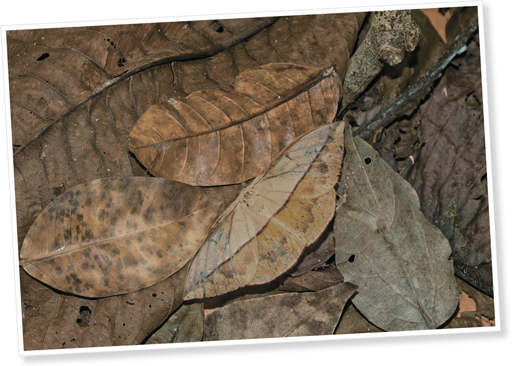
How are features shared between lepidopterans?
As adults, all lepidopterans have three pairs of legs and two pairs of wings covered with small scales. As juveniles, they have a well-developed head and many chewing mouthparts. But there are still differences between individuals
What does the moth and its relatives represent?
It illustrates the striking ways in which organisms are suited for life in their environments, the many shared characteristics (unity) of life, and the rich diversity of life
[[Environment:[[
Other organisms as well as the physical aspects of an organism’s surroundings
[[Evolution:[[
Descent with modification; the idea that living species are descendants of ancestral species that were different from the present-day ones; also defined more narrowly as the change in the genetic composition of a population from generation to generation
^^19.1 - The Darwinian revolution challenged traditional views of a young Earth inhabited by unchanging species^^
Darwin proposed that life’s diversity arose from ancestral species through natural selection, a departure from prevailing views
Cuvier studied fossils but denied that evolution occurs; he proposed that sudden catastrophic events in the past caused species to disappear from an area. Hutton and Lyell thought that geologic change could result from gradual, continuous mechanisms. Lamarck hypothesized that species evolve, but the underlying mechanisms he proposed are not supported by evidence
Unusual species inspired novel ideas - Darwin observed this species of marine iguana and many other unique animals when he visited the Galápagos Islands in 1835
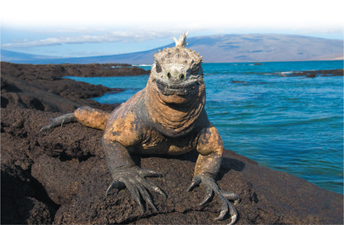
[[Scala Naturae:[[
Scale of nature; how life-forms are arranged on a ladder of increasing complexity
Binomial Format:
The two-part format for naming species (Homo sapiens) developed by Linnaeus that’s still used today
Describe Linnaeus’ nested classification system
It groups similar species into increasingly general categories. For example, similar species are grouped in the same genus, similar genera (plural of genus) are grouped in the same family, and so on. It was not based on resemblances among species to evolutionary kinship, but rather on the pattern of their creation
Linnaean classification - At each level, or “rank,” species are placed in groups within more inclusive groups
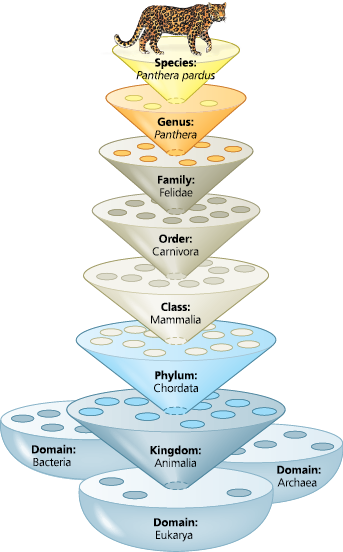
[[Fossil:[[
A preserved remnant or impression of an organism that lived in the past
[[Stratum:[[
A rock layer formed when new layers of sediment cover older ones and compress them
Formation of sedimentary strata with fossils
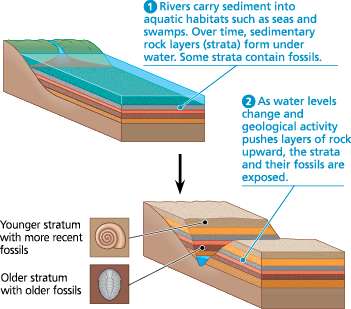
[[Paleontology:[[
The scientific study of fossils
Cuvier noted that the older the stratum, the more ___ its fossils were to current life-forms. He also observed that from one layer to the next, some species _
- dissimilar; newly appeared or disappeared
How do geologic and biologic changes relate to each other?
They are both slow continuous actions rather than sudden events. It takes a long time for a river to carve a canyon by erosion and takes a gradual change for biological evolution
[[Use and Disuse:[[
The idea that parts of the body that are used extensively become larger and stronger, while those that are not used deteriorate
[[Inheritance of Acquired Characteristics:[[
The idea that an organism could pass these modifications to its offspring
Lamarck also thought that evolution happens because organisms have an innate drive to become ___
- more complex
Lamarck’s proposals were ___
- wrong L
Acquired traits cannot be inherited - This bonsai tree was “trained” to grow as a dwarf by pruning and shaping. However, seeds from this tree would produce offspring of normal size
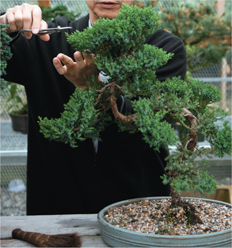
^^How did Hutton’s and Lyell’s ideas influence Darwin’s thinking about evolution?^^
Heterochrony can cause a variety of morphological changes. For example, if the onset of sexual maturity changes, a retention of juvenile characteristics (paedomorphosis) may result. Paedomorphosis can be caused by small genetic changes that result in large changes in morphology, as seen in the axolotl salamander
^^Scientific hypotheses must be testable. Applying this criterion, are Cuvier’s explanation of the fossil record and Lamarck’s hypothesis of evolution scientific?^^
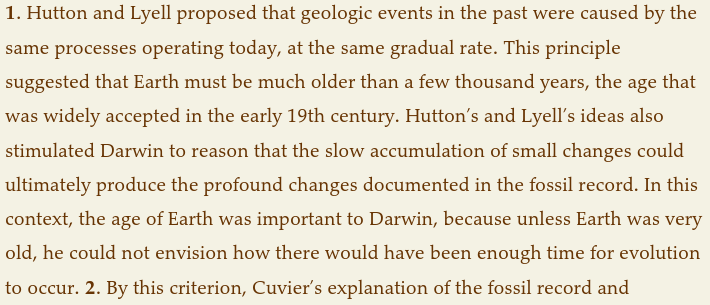
^^Why was the age of Earth important for Darwin’s ideas about evolution?^^
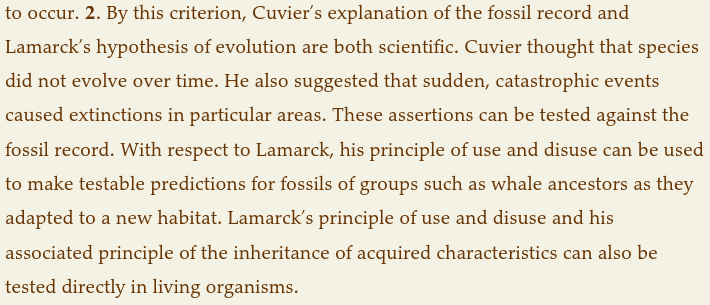
^^19.2 - Descent with modification by natural selection explains the adaptations of organisms and the unity and diversity of life^^
Darwin’s voyage on the Beagle gave rise to his idea that species originate from ancestral forms through the accumulation of adaptations. He refined his theory for many years and finally published it in 1859 after learning that Wallace had come to the same idea
In The Origin of Species, Darwin proposed that over long periods of time, descent with modification produced the rich diversity of life through the mechanism of natural selection
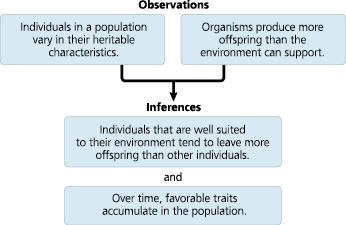
Physical evidence ___ the traditional view that Earth was only a few thousand years old
- did not support
What did Darwin conclude from observing some organisms on the Galápagos that were unique and some that resembled species from South America?
The Galápagos had been colonized by organisms that had strayed from South America and then diversified, giving rise to new species on the various islands
The voyage of HMS Beagle (December 1831–October 1836)
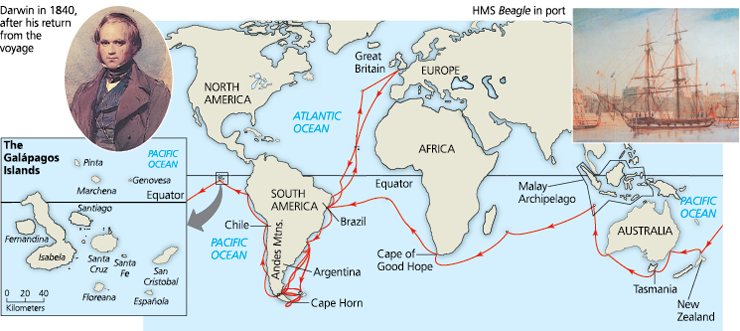
[[Adaptation:[[
Inherited characteristic of an organism that enhances its survival and reproduction in a specific environment
[[Natural Selection:[[
A process in which individuals that have certain inherited traits tend to survive and reproduce at higher rates than other individuals because of those traits
Three examples of beak variation in Galápagos finches - The Galápagos Islands are home to more than a dozen species of closely related finches, some found only on a single island. A striking difference among them is their beaks, which are adapted for specific diets
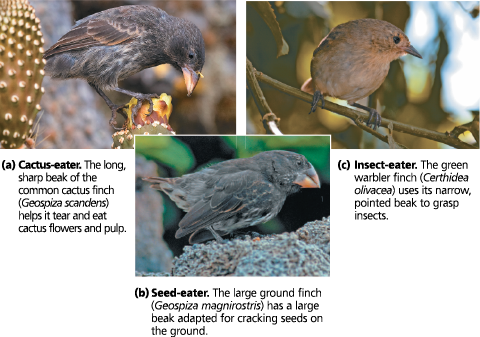
^^Review Figure 1.17. To which of the other two species shown above is the common cactus finch more closely related (that is, with which species does the common cactus finch share a more recent common ancestor)?^^
The common cactus finch is more closely related to the large ground finch; Figure 1.17 shows that they share a more recent common ancestor than the common cactus finch shares with the green warbler finch
Alfred Russel Wallace - The inset is a painting Wallace made of a flying tree frog from the Malay Archipelago

How did Darwin describe the unity of life?
He claimed it was due to the descent of all organisms from an ancestor that lived in the remote past.
How did Darwin describe the rich diversity of life we see today?
He claimed organisms gradually accumulated diverse modifications, or adaptations, that fit them to specific ways of life
“I think . . .” - In this 1837 sketch, Darwin envisioned the branching pattern of evolution. Branches that end in twigs labeled A–D represent particular groups of living organisms; all other branches represent extinct groups
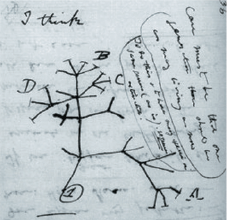
Descent with modification - This evolutionary tree of elephants and their relatives is based mainly on fossils—their anatomy, order of appearance in strata, and geographic distribution. Note that most branches of descent ended in extinction (denoted by the dagger symbol †). (Time line not to scale.)
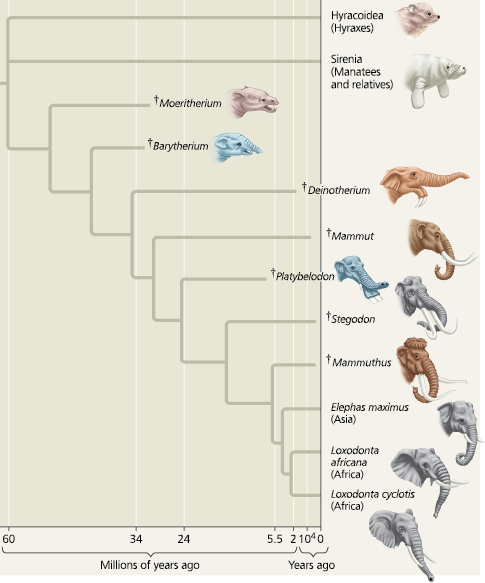
^^Based on the tree shown here, approximately when did the most recent ancestor shared by Mammuthus (woolly mammoths), Asian elephants, and African elephants live?^^
The common ancestor lived more than 5.5 million years ago
In fact, many evolutionary branches, even some major ones, are dead ends: Scientists estimate that over ___ of all species that have ever lived are now extinct
- 99%
[[Artificial Selection:[[
The selective breeding of domesticated plants and animals to encourage the occurrence of desirable traits
Artificial Selection - These different vegetables have all been selected from one species of wild mustard. By selecting variations in different parts of the plant, breeders have obtained these divergent results
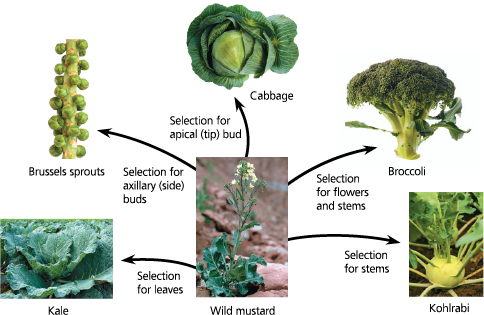
As a result of artificial selection, crops, livestock animals, and pets often bear ___ resemblance to their wild ancestors
- little
^^Darwin’s observations and inferences:^^
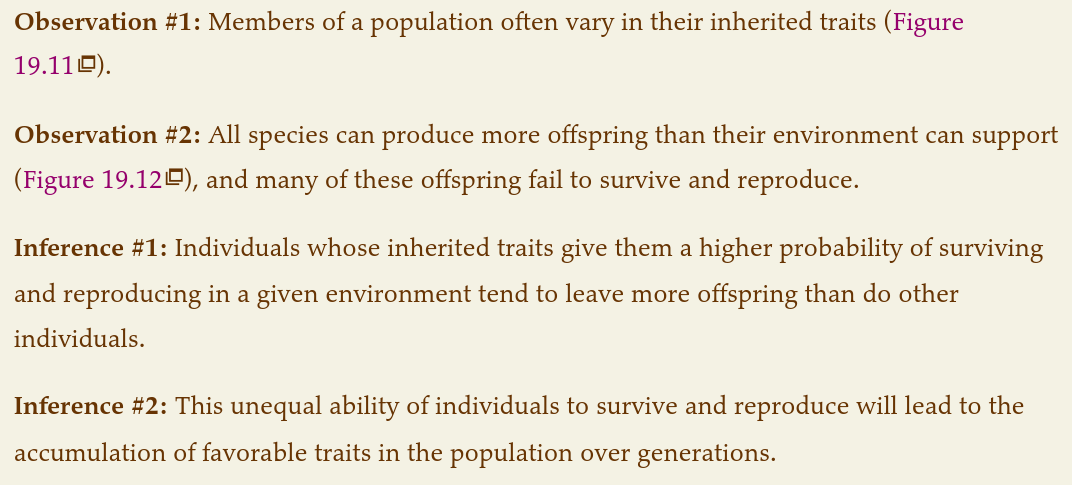
Variation in a population - Individuals in this population of Asian ladybird beetles vary in color and spot pattern. Natural selection may act on these variations only if (1) they are heritable and (2) they affect the beetles’ ability to survive and reproduce
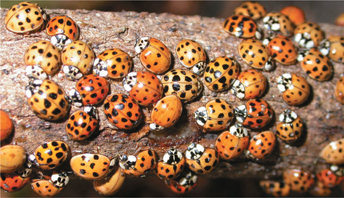
Overproduction of offspring - A single puffball fungus can produce billions of spores that give rise to offspring. If all of these offspring and their descendants survived to maturity, they would carpet the surrounding land
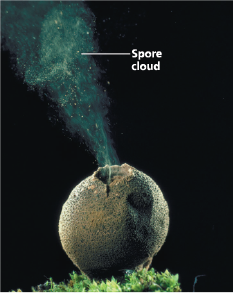
An organism’s heritable traits can influence not only its own performance, but also how well ___
- its offspring cope with environmental challenges
Key Features of Natural Selection:
- Natural selection is a process in which individuals that have certain heritable traits survive and reproduce at a higher rate than do other individuals because of those traits
- Over time, natural selection can increase the frequency of adaptations that are favorable in a given environment
- If an environment changes, or if individuals move to a new environment, natural selection may result in adaptation to these new conditions, sometimes giving rise to new species
Camouflage as an example of evolutionary adaption - Related species of the insects called mantises have diverse shapes and colors that evolved in different environments, as seen in this Malaysian orchid mantis (top) and South African flower-eyed mantis (bottom)
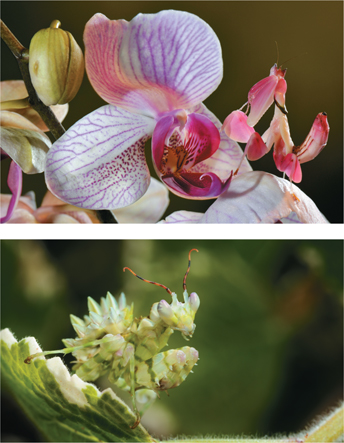
^^Explain how these mantises demonstrate the three key observations about life introduced at the beginning of this chapter: how organisms are well suited for life in their environments, unity, and diversity^^
The colors and body forms of these mantises allow them to blend into their surroundings, providing an example of how organisms are well suited for life in their environments. The mantises also share features with one another (and with all other mantises), such as six legs, grasping forelimbs, and large eyes. These shared features illustrate another key observation about life: the unity of life that results from descent from a common ancestor. Over time, as these mantises diverged from a common ancestor, they accumulated different adaptations that made them well suited for life in their different environments. Eventually, as enough differences accumulated between mantis populations, new species were formed, thus contributing to the great diversity of life
lthough natural selection occurs through interactions between individual organisms and their environment, ___ do not evolve but a _ does over time
- individuals; population
Natural selection can amplify or diminish only those heritable traits that ___ among the individuals in a population
- differ
Environmental factors ___ from place to place and over time
- vary
^^How does the concept of descent with modification explain both the unity and diversity of life?^^
Organisms share characteristics (the unity of life) because they share common ancestors; the great diversity of life occurs because new species have repeatedly formed when descendant organisms gradually adapted to different environments, becoming different from their ancestors
^^Predict whether a fossil of an extinct mammal that lived high in the Andes would more closely resemble present-day mammals that live in South American jungles or present-day mammals that live high in Asian mountains^^
The fossil mammal species (or its ancestors) would most likely have colonized the Andes from within South America, whereas ancestors of mammals currently found in Asian mountains would most likely have colonized those mountains from other parts of Asia. As a result, the Andes fossil species would share a more recent common ancestor with South American mammals than with mammals in Asia. Thus, for many of its traits, the fossil mammal species would probably more closely resemble mammals that live in South American jungles than mammals that live on Asian mountains. It is also possible, however, that the fossil mammal species could resemble the Asian mountain mammals because similar environments selected for similar adaptations (even though they were only distantly related to one another)
^^Suppose that in a particular pea population, flowers with the white phenotype are favored by natural selection. Predict what would happen over time to the frequency of the p allele in the population, and explain your reasoning^^
As long as the white phenotype (encoded by the genotype pp) continues to be favored by natural selection, the frequency of the p allele will likely increase over time in the population. If the proportion of white individuals increases relative to purple individuals, the frequency of the recessive p allele will also increase relative to that of the P allele, which only appears in purple individuals (some of which also carry a p allele)
^^Describe how overreproduction and heritable variation relate to evolution by natural selection^^
All species have the potential to overreproduce—that is, to produce more offspring than can be supported by the environment. This ensures that there will be what Darwin called a “struggle for existence” in which many of the offspring are eaten, starved, diseased, or unable to reproduce for a variety of other reasons. Members of a population exhibit a range of heritable variations, some of which make it likely that their bearers will leave more offspring than other individuals (for example, the bearer may escape predators more effectively or be more tolerant of the physical conditions of the environment). Over time, natural selection resulting from factors such as predators, lack of food, or the physical conditions of the environment can increase the proportion of individuals with favorable traits in a population (evolutionary adaptation)
^^19.3 - Evolution is supported by an overwhelming amount of scientific evidence^^
Researchers have directly observed natural selection leading to adaptive evolution in many studies, including research on soapberry bug populations and on MRSA
Organisms share characteristics because of common descent (homology) or because natural selection affects independently evolving species in similar environments in similar ways (convergent evolution)
Fossils show that past organisms differed from living organisms, that many species have become extinct, and that species have evolved over long periods of time; fossils also document the origin of major new groups of organisms
Evolutionary theory can explain some biogeographic patterns
Direct Observations
When seeds are close to the fruit surface, soapberry bugs’ beaks are ___
- shorter
Beak lengths were shorter in populations feeding on the introduced species than in populations feeding on the native species, in which the seeds are buried more deeply. The average beak length in museum specimens from each population (indicated by red arrows) was similar to beak lengths in populations feeding on native species 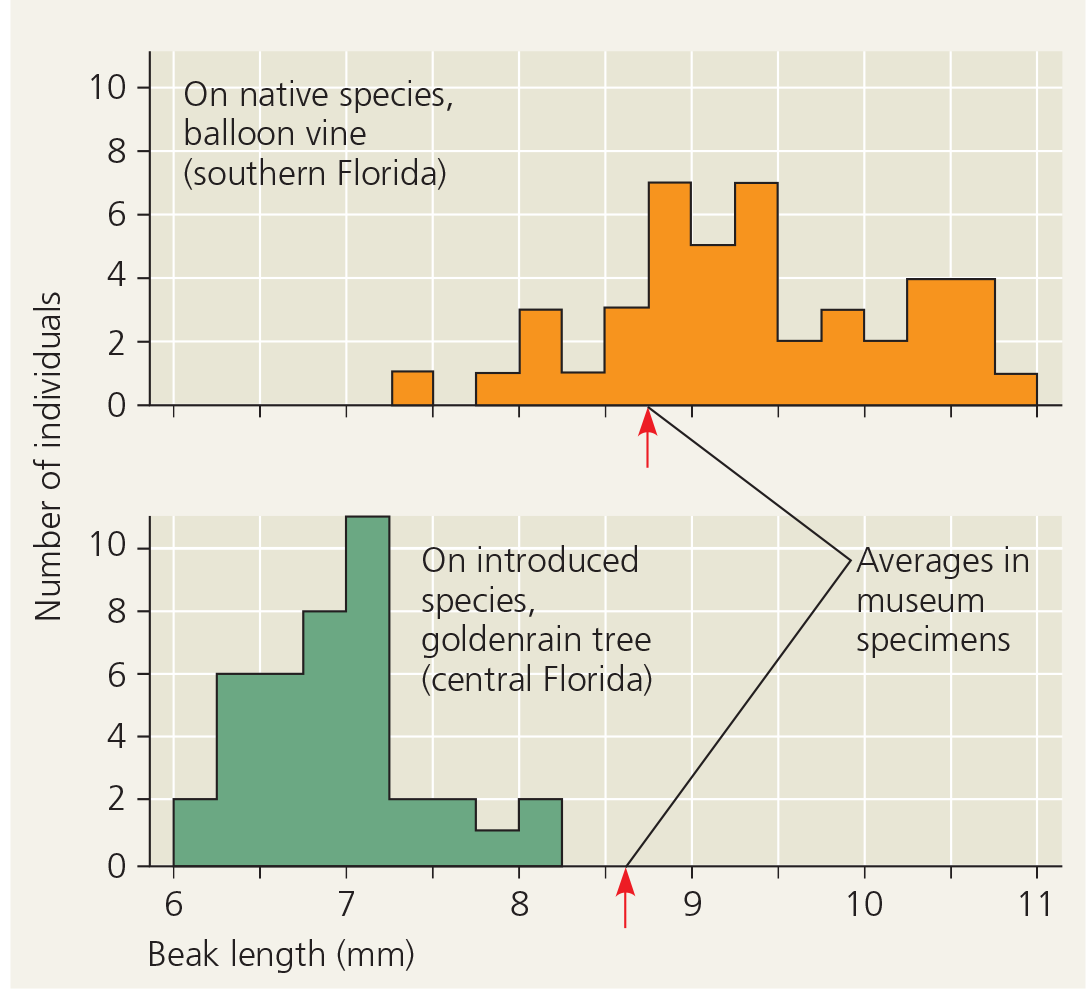
Museum specimens and contemporary data suggest that a change in the size of the soapberry bug’s food source can result in evolution by natural selection for matching beak size
^^Data from additional studies showed that when soapberry bug eggs from a population fed on balloon vine fruits were reared on goldenrain tree fruits (or vice versa), the beak lengths of the adult insects matched those in the population from which the eggs were obtained. Interpret these results^^
These results show that being reared from the egg stage on one plant species or the other did not result in the adult having a beak length appropriate for that host; instead, adult beak lengths were determined primarily by the population from which the eggs were obtained. Because an egg from a balloon vine population likely had long-beaked parents, while an egg from a goldenrain tree population likely had short-beaked parents, these results indicate that beak length is an inherited trait
When the fruit of the introduced plants is larger than the fruit of the native plant, natural selection will result in ___ beaks
- longer
How have drug-resistant bacteria evolved?
Pathogens have become resistant and can proliferate quickly. For example, methicillin-resistant Staphylococcus aureus can cause infections and diseases
The rise of methicillin-resistant Staphylococcus aureus (MRSA)
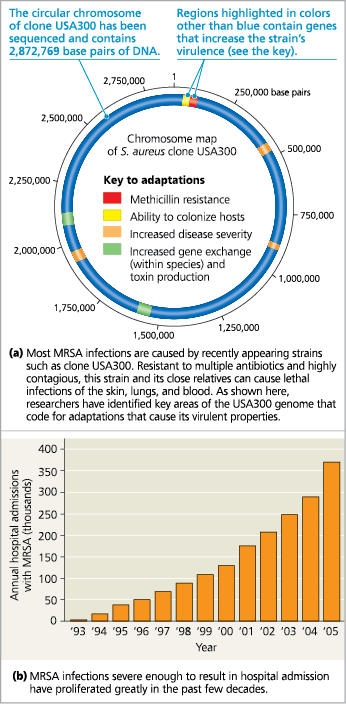
Penicillin-resistant bacteria had penicillinase that could ___ penicillin
- destroy
Methicillin works by deactivating an enzyme that bacteria use to synthesize their cell walls. Resisant strains were able to ___ their cell walls using _
- synthesize; an enzyme unaffected by methicillin
Natural selection is a process of ___, not a creative mechanism
- editing
Natural selection depends on ___. It favors those characteristics in a genetically variable population that provide an advantage in the _ environment
- time and place; current, local
Homology
What’s the result of descendants facing different environmental conditions?
Related species can have characteristics that have an underlying similarity yet function differently
[[Homology:[[
Similarity in characteristics resulting from a shared ancestry
[[Homologous Structures:[[
Structures in different species that are similar because of common ancestry
Mammalian forelimbs: homologous structures - Even though they have become adapted for different functions, the forelimbs of all mammals are constructed from the same basic skeletal elements: one large bone (purple), attached to two smaller bones (orange and tan), attached to several small bones (gold), attached to several metacarpals (green), attached to approximately five digits, each of which is composed of multiple phalanges (blue)
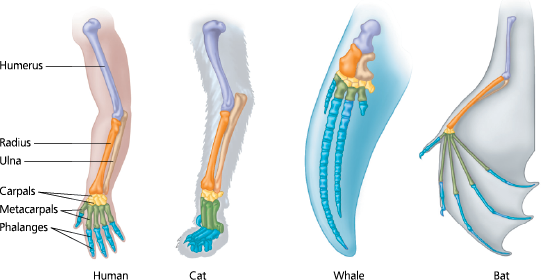
Anatomical similarities in vertebrate embryos - At some stage in their embryonic development, all vertebrates have a tail located posterior to the anus (referred to as a post-anal tail), as well as pharyngeal (throat) arches. Descent from a common ancestor can explain such similarities
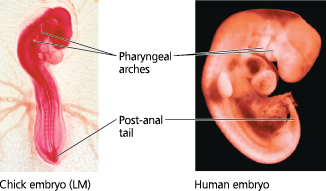
[[Vestigal Structures:[[
A feature of an organism that is a historical remnant of a structure that served a function in the organism’s ancestors
The skeletons of some snakes retain ___ of the pelvis and leg bones of walking ancestors
- vestiges
All forms of life use essentially the same ___, suggesting that all species descended from _ that used this code
- genetic code; common ancestors
[[Convergent Evolution:[[
The evolution of similar features in independent evolutionary lineages
[[Analogous:[[
Having characteristics that are similar because of convergent evolution, not homology
Convergent evolution - The ability to glide through the air evolved independently in these two distantly related mammals

Fossil Record
What do fossils show?
They document the pattern of evolution, showing that past organisms differed from present-day organisms and that many species have become extinct. Fossils also show the evolutionary changes that have occurred in various groups of organisms. They can show how many years ago something lived
The pelvic bone in fossil stickleback fish became greatly reduced in size over time in a number of different lakes which shows the size may have been driven by ___
- natural selection
Ankle bones: one piece of the puzzle - Comparing fossils and present-day examples of the astragalus (a type of ankle bone) indicates that cetaceans are closely related to even-toed ungulates. (a) In most mammals, the astragalus is shaped like that of a dog, with a double hump on one end (indicated by the red arrows) but not at the opposite end (blue arrow). (b) Fossils show that the early cetacean Pakicetus had an astragalus with double humps at both ends, a shape otherwise found only in (c) pigs, (d) deer, and all other even-toed ungulates
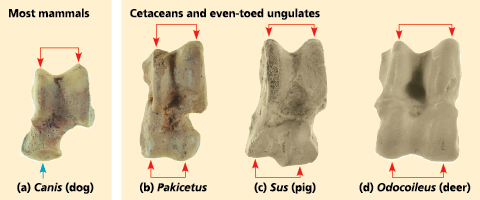
The transition to life in the sea - Multiple lines of evidence support the hypothesis that cetaceans (highlighted in yellow) evolved from terrestrial mammals. Fossils document the reduction over time in the pelvis and hind limb bones of extinct (†) cetacean ancestors, including Pakicetus, Rodhocetus, and Dorudon. DNA sequence data support the hypothesis that cetaceans are most closely related to hippopotamuses
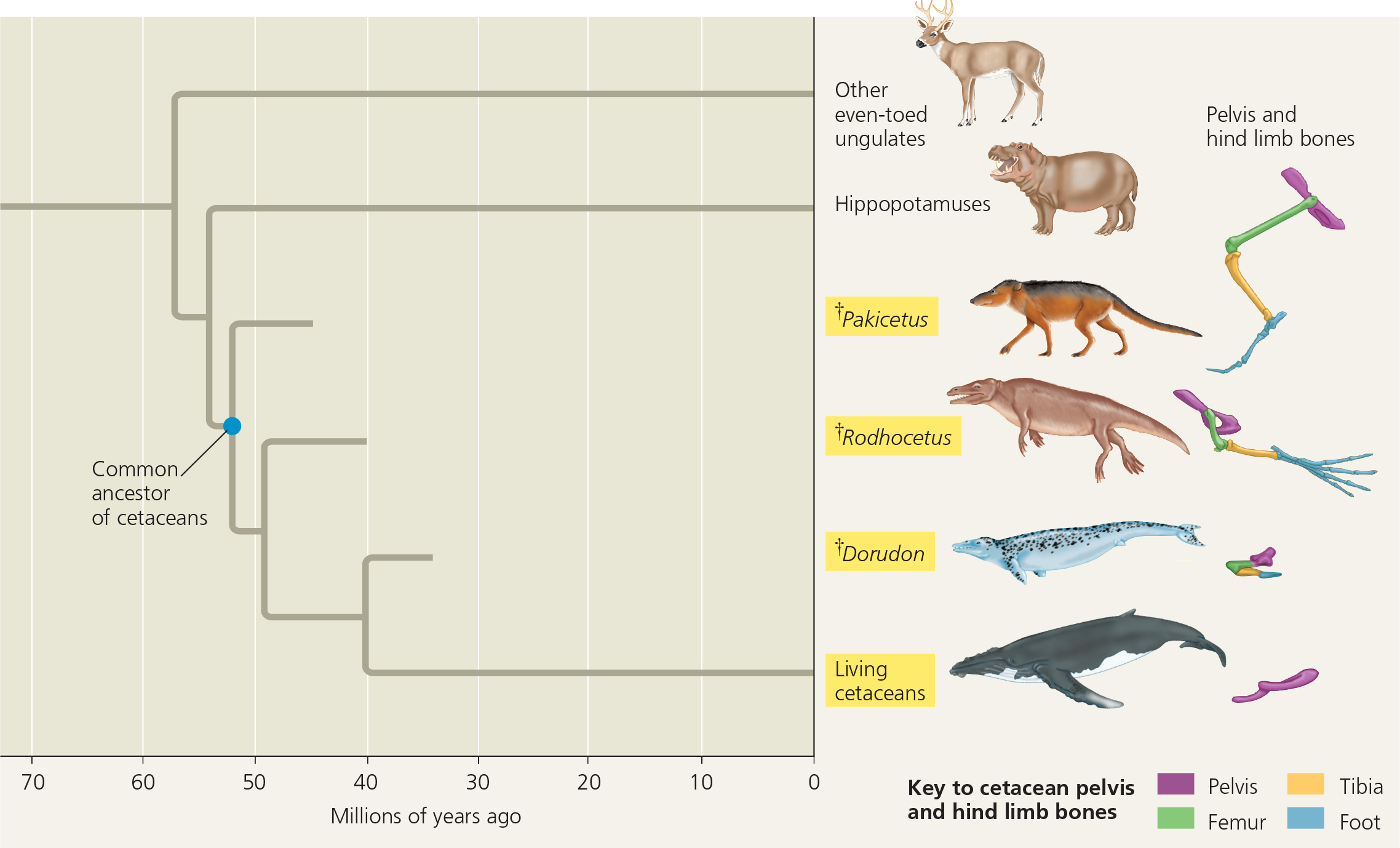
^^Which happened first during the evolution of cetaceans: changes in hind limb structure or the origin of tail flukes? Explain^^
Hind limb structure changed first. Rodhocetus lacked flukes, but its pelvic bones and hind limbs had changed substantially from how those bones were shaped and arranged in Pakicetus. For example, in Rodhocetus, the pelvis and hind limbs appear to be oriented for paddling, whereas they were oriented for walking in Pakicetus
The fossil record shows that over time, descent with modification produced increasingly large differences among related groups of organisms, ultimately resulting in the diversity of life we see today
- increasingly large differences
Biogeography
[[Biogeography:[[
The scientific study of the past and present geographic distributions of species
[[Pangaea:[[
The supercontinent that formed near the end of the Paleozoic era, when plate movements brought all the landmasses of Earth together
[[Endemic:[[
Referring to a species that is confined to a specific geographic area
Islands are colonized by species from the nearest mainland. These colonists eventually give rise to new species as they ___ to their new environments
- adapt
Two islands with similar environments in distant parts of the world tend to be populated not by species that are closely related to each other, but rather by species related to those of ___, where the environment is often quite different
- the nearest mainland
What are the pros and cons of the various colored male guppies?
Bright-colored guppies will be chosen more by females, but they will also be more conspicuous to predators. In pools with few predators, males are more brightly colored than in pools with more predators
Researchers transplanted 200 guppies from pools containing pike-cichlid fish, intense predators of adult guppies, to pools containing killifish, less active predators that prey mainly on juvenile guppies. They tracked the number of bright-colored spots and the total area of those spots on male guppies in each generation 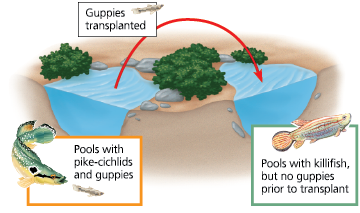
After 22 months (15 generations), researchers compared the color pattern data for guppies from the source and transplanted populations 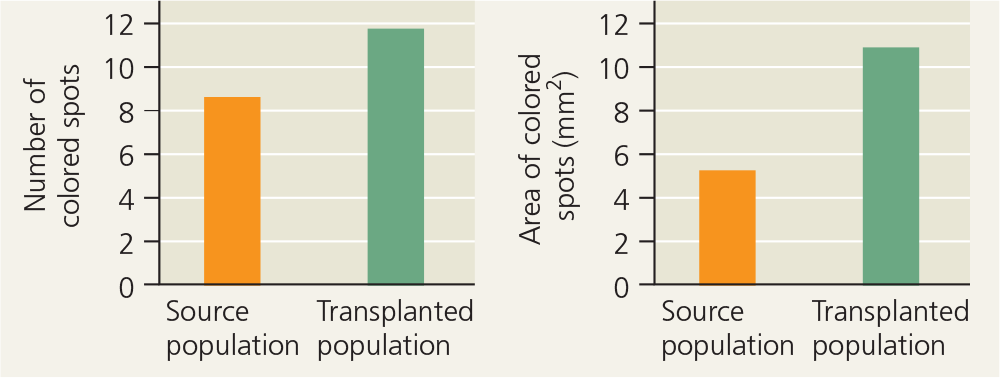
^^Explain how the following statement is inaccurate: “Antibiotics have created drug resistance in MRSA.”^^
An environmental factor such as a drug does not create new traits, such as drug resistance, but rather selects for traits among those that are already present in the population
^^How does evolution account for (a) the similar mammalian forelimbs with different functions shown in Figure 19.16 and (b) the similar forms of the two distantly related mammals shown in Figure 19.18?^^
(a) Despite their different functions, the forelimbs of different mammals are structurally similar because they all represent modifications of a structure found in the common ancestor. (b) This is a case of convergent evolution. The similarities between the sugar glider and flying squirrel indicate that similar environments selected for similar adaptations despite different ancestry
^^Fossils show that dinosaurs originated between 200 and 250 million years ago. Would you expect the geographic distribution of early dinosaur fossils to be broad (on many continents) or narrow (on one or a few continents only)?^^
At the time that dinosaurs originated, Earth’s landmasses formed a single large continent, Pangaea. Because many dinosaurs were large and mobile, it is likely that early members of these groups lived on many different parts of Pangaea. When Pangaea broke apart, fossils of these organisms would have moved with the rocks in which they were deposited. As a result, we would predict that fossils of early dinosaurs would have a broad geographic distribution (this prediction has been upheld)
^^Summarize the different lines of evidence supporting the hypothesis that cetaceans descended from land mammals and are closely related to even-toed ungulates^^
The hypothesis that cetaceans originated from a terrestrial mammal and are closely related to even-toed ungulates is supported by several lines of evidence. For example, fossils document that early cetaceans had hind limbs, as expected for organisms that descended from a land mammal; these fossils also show that cetacean hind limbs became reduced over time. Other fossils show that early cetaceans had a type of ankle bone that is otherwise found only in even-toed ungulates, providing strong evidence that even-toed ungulates are the land mammals to which cetaceans are most closely related. DNA sequence data also indicate that even-toed ungulates are the land mammals to which cetaceans are most closely related